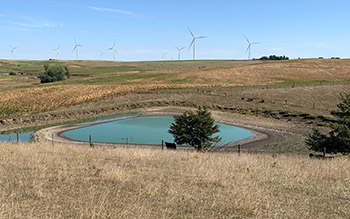Rebuilding water infrastructure during drought
11/21/23
LEWIS, Iowa – While limited water presents significant challenges for livestock producers during drought, low water levels do offer an opportunity to make improvements in infrastructure to capitalize on future precipitation. Implementing effective water management strategies ensure productivity and health of the cow herd.
Over time, cattle traffic in and out of the pond can hinder dam integrity and result in shallow waters at access points. While water levels are low, consider cleaning out the ponds and restoring to a desirable slope of 3:1 (for every 3 feet in horizontal depth, there sound be 1 foot in rise) to reduce growth of unwanted vegetative along the shorelines including cattails. Low levels also allow for giving attention to drain and overflow pipes, fixing any leaks in the dam as well as renovating the dam to maintain or improve integrity. This includes removing unwanted trees and undesirable wildlife. Care should be given to not disturb the clay lining.
If properly managed, vegetation around the water source aides in precipitation infiltration allowing for forage utilization and travel to the water storage basin. In addition, vegetation allows for reduced erosion, preserving water quality by not adding extra sediments to the pond. While it’s too late to focus on forage recovery for this year, prioritize fostering vegetation growth around the pond next spring. Options include allowing rest and interseeding a cool season annual forage. Having forage up to the side of the pond can also provide some shade and ultimately insulate water and reduce evaporation.
Water quality is already a concern during drought as nutrients and sediments are concentrated when water levels are reduced. Unlimited access for cattle allows for further degradation of water quality. Fencing off around the pond or streams can help protect water quality and reduce erosion. At least a 50-foot-wide buffer is suggested, but up to 100 feet may be ideal for steeper slopes.
In addition to fencing off the pond, adding a stock tank below can prove beneficial. Previous research documented almost a 10% increase in weight gain of nursing calves when pairs drank from a water tank compared to directly from the pond. While pumping into a tank didn’t significantly improve water quality, the aeration appeared to help with water intake and palatability. Plan to have 3 inches of linear water space per pair and adequate water pressure to refill the stock tank in a timely matter.
Many climate reports are not optimistic for rainfall in the 2024 growing season. If the drought-stricken ponds from 2023 face additional shortages of precipitation, the need for water infrastructure improvements will be emphasized, particularly for those forced to haul water. With high calf prices this year and the current state of ponds in the pasture, the prospect of laying pipe and connecting to rural water sources are worth exploring. Water is the most critical nutrient for all livestock and having a reliable source is essential to production.
Originally published in the November issue of the Iowa Forage and Grassland Council's "The Forager."
-30-
The Iowa Beef Center at Iowa State University was established in 1996 with the goal of supporting the growth and vitality of the state’s beef cattle industry. It comprises faculty and staff from Iowa State University Extension and Outreach, College of Agriculture and Life Sciences and College of Veterinary Medicine, and works to develop and deliver the latest research-based information regarding the beef cattle industry. For more information about IBC, visit www.iowabeefcenter.org.
Contact:
Erika Lundy-Woolfolk, ISU Extension and Outreach beef specialist, 641-745-5902, ellundy@iastate.edu

